Prediction of Geosmin at Different Depths of Lake Using Machine Learning Techniques
Abstract
:1. Introduction
2. Materials and Methods
2.1. Ecological Data
2.2. Data Analysis
3. Results
3.1. Relations between Geosmin and Phytoplankton Abundance and Environmental Variables
3.2. Prediction of Geosmin Concentration
4. Discussion
5. Conclusions
Author Contributions
Funding
Institutional Review Board Statement
Informed Consent Statement
Conflicts of Interest
References
- Bruder, S.; Babbar-Sebens, M.; Tedesco, L.; Soyeux, E. Use of fuzzy logic models for prediction of taste and odor compounds in algal bloom-affected inland water bodies. Environ. Monit. Assess. 2014, 186, 1525–1545. [Google Scholar] [CrossRef]
- Harris, T.D.; Graham, J.L. Predicting cyanobacterial abundance, microcystin, and geosmin in a eutrophic drinking-water reservoir using a 14-year dataset. Lake Reserv. Manag. 2017, 33, 32–48. [Google Scholar] [CrossRef]
- Dodds, W.K.; Bouska, W.W.; Eitzmann, J.L.; Pilger, T.J.; Pitts, K.L.; Riley, A.J.; Schloesser, J.T.; Thornbrugh, D.J. Eutrophication of U.S. freshwaters: Analysis of potential economic damages. Environ. Sci. Technol. 2009, 43, 12–19. [Google Scholar] [CrossRef] [Green Version]
- Christensen, V.G.; Graham, J.L.; Milligan, C.R.; Pope, L.M.; Zeigler, A.C. Water quality and relation to tasteand-odor compounds in the North Fork Ninnescah River and Cheney Reservoir, Southcentral Kansas, 1997–2003. In Scientific Investigations Report 2006–5095; US Geological Survey: Reston, VA, USA, 2006; pp. 1–43. [Google Scholar] [CrossRef]
- Chung, S.-W.; Chong, S.A.; Park, H.-S. Development and applications of a predictive model for geosmin in North Han River, Korea. Procedia Eng. 2016, 154, 521–528. [Google Scholar] [CrossRef]
- Srinivasan, R.; Sorial, G.A. Treatment of taste and odor causing compounds 2-mdethyl isoborneol and geosmin in drinking water: A critical review. J. Environ. Sci. 2011, 23, 1–13. [Google Scholar] [CrossRef]
- Smith, V.H.; Sieber-Denliger, J.; DeNoyelles, F.; Campbell, S.; Pan, S.; Randtke, S.J.; Blain, G.T.; Strasser, V.A. Managing taste and odor problems in a eutrophic drinking water reservoir. Lake Reserv. Manag. 2002, 18, 319–323. [Google Scholar] [CrossRef] [Green Version]
- Watson, S.B. Aquatic taste and odour: A primary signal of drinking water integrity. J. Toxicol. Environ. Health 2004, 67, 1779–1795. [Google Scholar] [CrossRef] [PubMed]
- Gerber, N.N.; Lechevalier, H.A. Geosmin, and earthy-smelling substances isolated from actinomycetes. Appl. Microbiol. 1967, 13, 935–938. [Google Scholar] [CrossRef] [PubMed]
- Safferman, R.S.; Rosen, A.A.; Mashni, C.I.; Morris, M.E. Earthy-smelling substance from a blue-green alga. Environ. Sci. Technol. 1967, 1, 429–430. [Google Scholar] [CrossRef] [PubMed]
- Hsieh, W.-H.; Chang, D.-W.; Lin, T.-F. Occurrence and removal of earthy-musty odorants in two waterworks in Kinmen Island, Taiwan. J. Hazard. Toxic Radioact. Waste 2014, 18, 04014012. [Google Scholar] [CrossRef]
- Watershed, H.R. Watershed and Environment Management District (HRWEMD). In Distribution and Eco-Physiological Characteristics of Harmful Algae in the North Han River. Final Report; Han River Watershed Management Commission: Hanam, Korea, 2013. (In Korean) [Google Scholar]
- You, K.-A.; Byeon, M.-S.; Youn, S.-J.; Hwang, S.-J.; Rhew, D.-H. Growth characteristics of blue-green algae (Anabaena spiroides) causing tastes and odors in the North-Han River, Korea. Korean J. Ecol. Environ. 2013, 46, 135–144. [Google Scholar] [CrossRef]
- Ministry of Environment (MOE). Drinking Water Quality Monitoring Guideline; Ministry of Environment: Sejong-si, Korea, 2014. (In Korean)
- Ma, Z.; Xie, P.; Chen, J.; Niu, Y.; Tao, M.; Qi, M.; Zhang, W.; Deng, X. Microcystis blooms influencing volatile organic compounds concentrations in Lake Taihu. Fresenius Environ. Bull. 2013, 22, 95–102. [Google Scholar]
- Yagi, M.; Kajino, M.; Matsuo, U.; Ashitani, K.; Kita, T.; Nakamura, T. Odor problems in Lake Biwa. Water Sci. Technol. 1983, 15, 311–321. [Google Scholar] [CrossRef]
- Romero, J.; Ventura, F. Occurrence of Geosmin and Other Odorous Compounds of Natural Origin in Surface and Drinking Waters. A Case Study. Intern. J. Environ. Anal. Chem. 2000, 77, 243–254. [Google Scholar] [CrossRef]
- Jones, G.J.; Korth, W. In situ production of volatile odor compounds by river and reservoir phytoplankton populations in Australia. Water Sci. Technol. 1995, 31, 145–151. [Google Scholar] [CrossRef]
- Wnorowski, A.U.; Scott, W.E. Incidence of off-flavors in South-African surface waters. Water Sci. Technol. 1992, 1992. 25, 225–232. [Google Scholar] [CrossRef]
- Parinet, J.; Rodriguez, M.J.; Sérodes, J.-B. Modelling geosmin concentrations in three sources of raw water in Quebec, Canada. Environ. Monit. Assess. 2013, 185, 95–111. [Google Scholar] [CrossRef]
- Sugiura, N.; Utsumi, M.; Wei, B.; Iwami, N.; Okana, K.; Kawauchi, Y.; Maekawa, T. Assessment for the complicated occurrence of nuisance odours from phytoplankton and environmental factors in a eutrophic lake. Lakes Reserv. Res. Manag. 2004, 9, 195–201. [Google Scholar] [CrossRef]
- Dzialowski, A.R.; Smith, V.H.; Huggins, D.G.; deNoyelles, F.; Lim, N.C.; Baker, D.S.; Beury, J.H. Development of predictive models for geosmin-related taste and odor in Kansas, USA, drinking water reservoirs. Water Res. 2009, 43, 2829–2840. [Google Scholar] [CrossRef]
- Chong, S.; Lee, H.; An, K.-G. Predicting taste and odor compounds in a shallow reservoir using a three–dimensional hydrodynamic ecological model. Water 2018, 10, 1396. [Google Scholar] [CrossRef] [Green Version]
- Cox, E.J. Identification of Freshwater Diatoms from Live Material; Chapman & Hall: London, UK, 1996. [Google Scholar]
- Akiyama, M.; Loiya, T.; Imahori, K.; Kasaki, H.; Kumano, S.; Kobayashi, H.; Takahashi, E.; Tsumura, K.; Hirano, M.; Hirose, H.; et al. Illustration of the Japanese Freshwater Algae; Uchida Rockakuho Publishing Co.: Tokyo, Japan, 1977. [Google Scholar]
- Abe, T.H. Studies on the Order Peridinidae an Unfinished Monograph of the Armoured Dinoflagellata; The Nippon Printing and Publishing Co.: Tokyo, Japan, 1981. [Google Scholar]
- American Public Health Association (APHA). Standard Methods for the Examination of Water and Wastewater, 21st ed.; American Public Health Association: Washington, DC, USA, 2005. [Google Scholar]
- Fukuda, S.; de Baets, B.; Waegeman, W.; Verwaeren, J. Habitat prediction and knowledge extraction for spawning European grayling (Thymallus thymallus L.) using a broad range of species distribution models. Environ. Model. Softw. 2013, 47, 1–6. [Google Scholar] [CrossRef]
- Garzón, M.B.; Blazek, R.; Neteler, M.; de Dios, R.S.; Ollero, H.S.; Furlanello, C. Predicting habitat suitability with machine learning models: The potential area of Pinus sylvestris L. in the Iberian Peninsula. Ecol. Model. 2006, 197, 383–393. [Google Scholar] [CrossRef]
- Buisson, L.; Grenouillet, G.; Casajus, N.; Lek, S. Predicting the potential impacts of climate change on stream fish assemblages. Am. Fish. Soc. Symp. 2010, 73, 327–346. [Google Scholar] [CrossRef]
- Swets, J.A. Measuring the accuracy of diagnostic systems. Science 1988, 240, 1285–1293. [Google Scholar] [CrossRef] [PubMed] [Green Version]
- Robnik-Šikonja, M. Improving Random Forests. In Machine Learning ECML 2004; Boulicaut, J.-F., Esposito, F., Giannotti, F., Pedreschi, D., Eds.; Springer: Berlin/Heidelberg, Germany, 2004; pp. 359–370. [Google Scholar] [CrossRef] [Green Version]
- Milborrow, S. Earth: Multivariate Adaptive Regression Splines. R Package. Version 5.3.0. Available online: https://cran.r-project.org/ (accessed on 8 July 2021).
- Therneau, T.; Atkinson, B.; Ripley, B. Rpart: Recursive Partitioning and Regression Trees. R package. Version 4.1-15. Available online: https://cran.r-project.org/bin/windows/ (accessed on 8 July 2021).
- Robnik-Sikonja, M.; Savicky, P. CORElearn: CORElearn—Classification, Regression, Feature Evaluation. R Package. Version 1.54.2. Available online: https://cran.r-project.org/bin/windows/base/ (accessed on 8 July 2021).
- Peterson, A.T.; Soberón, J.; Pearson, R.G.; Anderson, R.P.; Martinez-Meyer, E.; Nakamura, M.; Araújo, M.B. Ecological Niches and Geographical Distributions; Princeton University Press: Princeton, NJ, USA, 2011. [Google Scholar]
- Helsel, D.R.; Hirsch, R.M. Statistical Methods in Water Resources; Elsevier: Amsterdam, The Netherlands, 1992. [Google Scholar]
- Ömür-Özbek, P.; Dietrich, A.M. Determination of Temperature-Dependent Henry’s Law Constants of Odorous Contaminants and Their Application to Human Perception. Environ. Sci. Technol. 2005, 2005. 39, 3957–3963. [Google Scholar] [CrossRef]
- Magara, Y.; Kunikane, S. Cost analysis of the adverse effects of algal growth in water bodies on drinking water supply. Ecol. Model. 1986, 1986. 31, 303–313. [Google Scholar] [CrossRef]
- Yagi, M. Musty odour problems in lake Biwa, 1982–1987. Water Sci. Technol. 1988, 1988. 20, 133–142. [Google Scholar] [CrossRef]
- Cook, D.; Newcombe, G.; Sztajnbok, P. The application of powdered activated carbon for MIB and geosmin removal: Predicting PAC doses in four raw waters. Water Res. 2001, 35, 1325–1333. [Google Scholar] [CrossRef]
- Whelton, A.J.; Dietrich, A.M. Relationship between intensity, concentration, and temperature for drinking water odorants, Water Res. 2004. Water Res. 2004, 38, 1604–1614. [Google Scholar] [CrossRef]
- Segurado, P.; Araújo, M. An evaluation of methods for modelling species distributions. J. Biogeogr. 2004, 2004. 31, 1555–1568. [Google Scholar] [CrossRef]
- Cutler, D.R.; Edwards, T.C., Jr.; Beard, K.H.; Cutler, A.; Hess, K.T.; Gibson, J.; Lawler, J.J. Random forests for classification in ecology. Ecology 2007, 88, 2783–2792. [Google Scholar] [CrossRef]
- Kwon, Y.-S.; Bae, M.-J.; Hwang, S.-J.; Kim, S.-H.; Park, Y.-S. Predicting potential impacts of climate change on freshwater fish in Korea. Ecol. Inform. 2015, 29, 156–165. [Google Scholar] [CrossRef]
- Tsao, H.W.; Michinaka, A.; Yen, H.K.; Giglio, S.; Hobson, P.; Monis, P.; Lin, T.F. Monitoring of geosmin producing Anabaena circinalis using quantitative PCR. Water Res. 2014, 49, 416–425. [Google Scholar] [CrossRef] [PubMed]
- Smith, J.L.; Boyer, G.L.; Zimba, P.V. A review of cyanobacterial odorous and bioactive metabolites: Impacts and management alternatives in aquaculture. Aquaculture 2008, 280, 5–20. [Google Scholar] [CrossRef]
- Jüttner, F.; Watson, S.B. Biochemical and ecological control of geosmin and 2-methylisoborneol in source waters. Appl. Environ. Microbiol. 2007, 73, 4395–4406. [Google Scholar] [CrossRef] [PubMed] [Green Version]
- Watson, S.B.; Monis, P.; Baker, P.; Giglio, S. Biochemistry and genetics of taste- and odor-producing cyanobacteria. Harmful Algae 2016, 54, 112–127. [Google Scholar] [CrossRef] [PubMed]
- Watson, S.B. Cyanobacterial and eukaryotic algal odour compounds: Signal or by-product? A review of their biological activity. Phycologia 2003, 42, 332–350. [Google Scholar] [CrossRef]
- Byun, J.H.; Hwang, S.J.; Kim, B.H.; Park, J.R.; Lee, J.K.; Lim, B.J. Relationship between a dense population of cyanobacteria and odorous compounds in the North Han River system in 2014 and 2015. Korean J. Ecol. Environ. 2015, 48, 263–271. [Google Scholar] [CrossRef]
- Youn, S.J.; Kim, Y.-J.; Kim, H.-N.; Kim, J.-Y.; Yu, M.-N.; Lee, E.J.; Yu, S.J. Geosmin and morphological characteristics of Anabaena circinalis, obtained from the Bukhan River. J. Environ. Sci. Int. 2018, 2018. 27, 27–38. [Google Scholar] [CrossRef]
- Ward, J.V.; Stanford, J.A. The serial discontinuity concept of lotic ecosystems. In Dynamics of Lotic Ecosystems; Fontaine, T.D., Bartell, S.M., Eds.; Ann Arbor Science: Ann Arbor, MI, USA, 1983; pp. 29–42. [Google Scholar]
- Byun, J.H.; Cho, I.H.; Hwang, S.J.; Park, M.H.; Byeon, M.S.; Kim, B.H. Relationship between a dense bloom of cyanobacterium Anabaena spp. and rainfalls in the North Han River system of South Korea. Korean J. Ecol. Environ. 2014, 2014. 47, 116–126. [Google Scholar] [CrossRef]
- Li, Z.; Yu, J.; Yang, M.; Zhang, D.; Burch, M.D.; Han, W. Cyanobacterial population and harmful metabolites dynamics during a bloom in Yanghe Reservoir, North China. Harmful Algae 2010, 9, 481–488. [Google Scholar] [CrossRef]
- Reynolds, C.S. Phytoplankton periodicity the interactions of form, function and environmental variability. Freshw. Biol. 1984, 14, 11–42. [Google Scholar] [CrossRef]
- Sommer, U.; Gliwicz, Z.M.; Lampert, W.; Duncan, A. The PEG-model of seasonal succession of planktonic events in fresh waters. Arch. Für Hydrobiol. 1986, 106, 433–471. [Google Scholar]
- Romo, S.; Miracle, M.R. Population dynamics and ecology of subdominant phytoplankton species in a shallow hypertrophic lake (Albufera of Valencia, Spain). Hydrobiologia 1994, 273, 37–56. [Google Scholar] [CrossRef]
- Kwon, Y.; Hwang, S.; Park, K.; Kim, H.; Kim, B.; Shin, K.; An, K.; Song, Y.; Park, Y. Temporal changes of phytoplankton community at different depths of a shallow hypertrophic reservoir in relation to environmental variables. Ann. Limnol. Int. J. Limnol. 2009, 45, 93–105. [Google Scholar] [CrossRef] [Green Version]
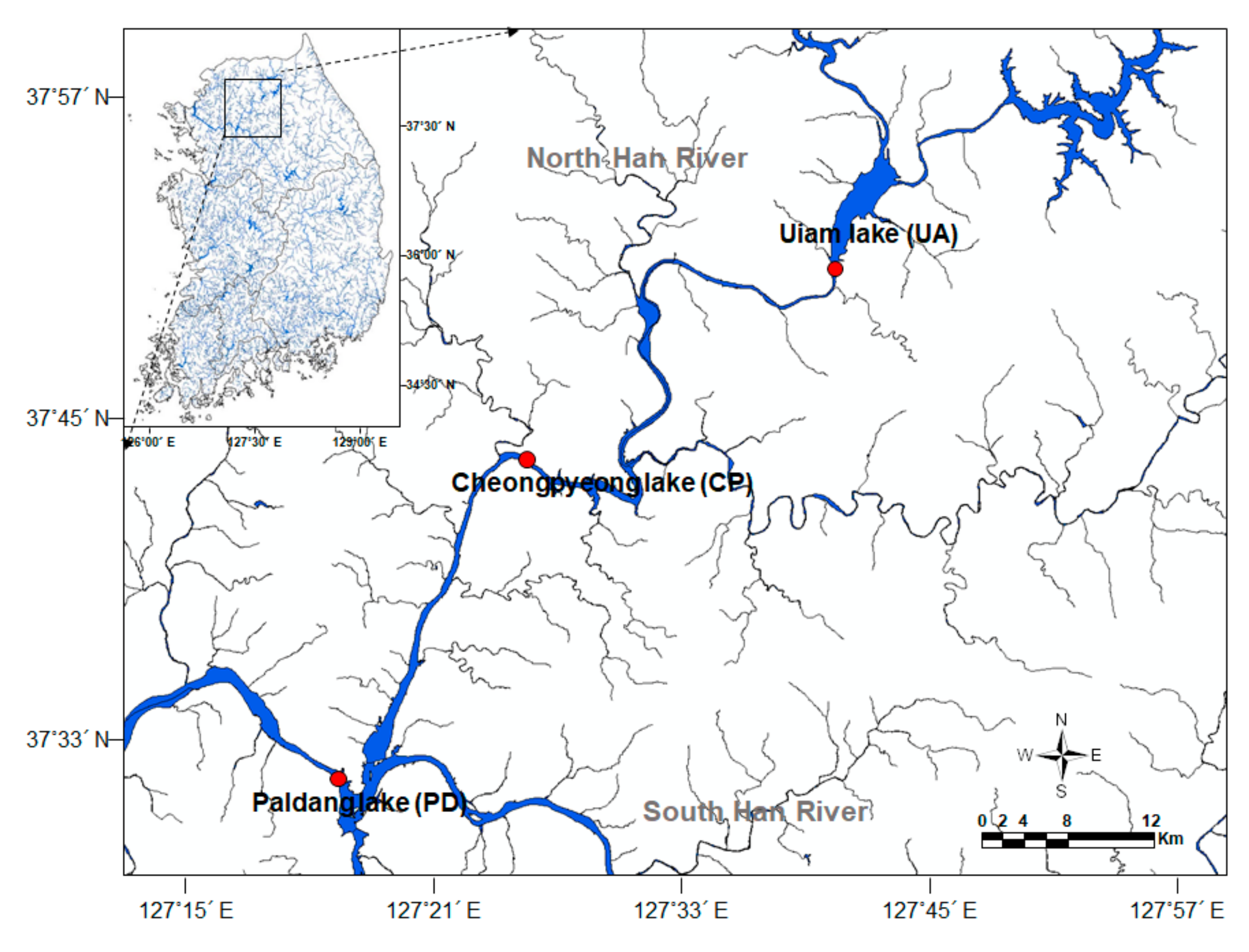
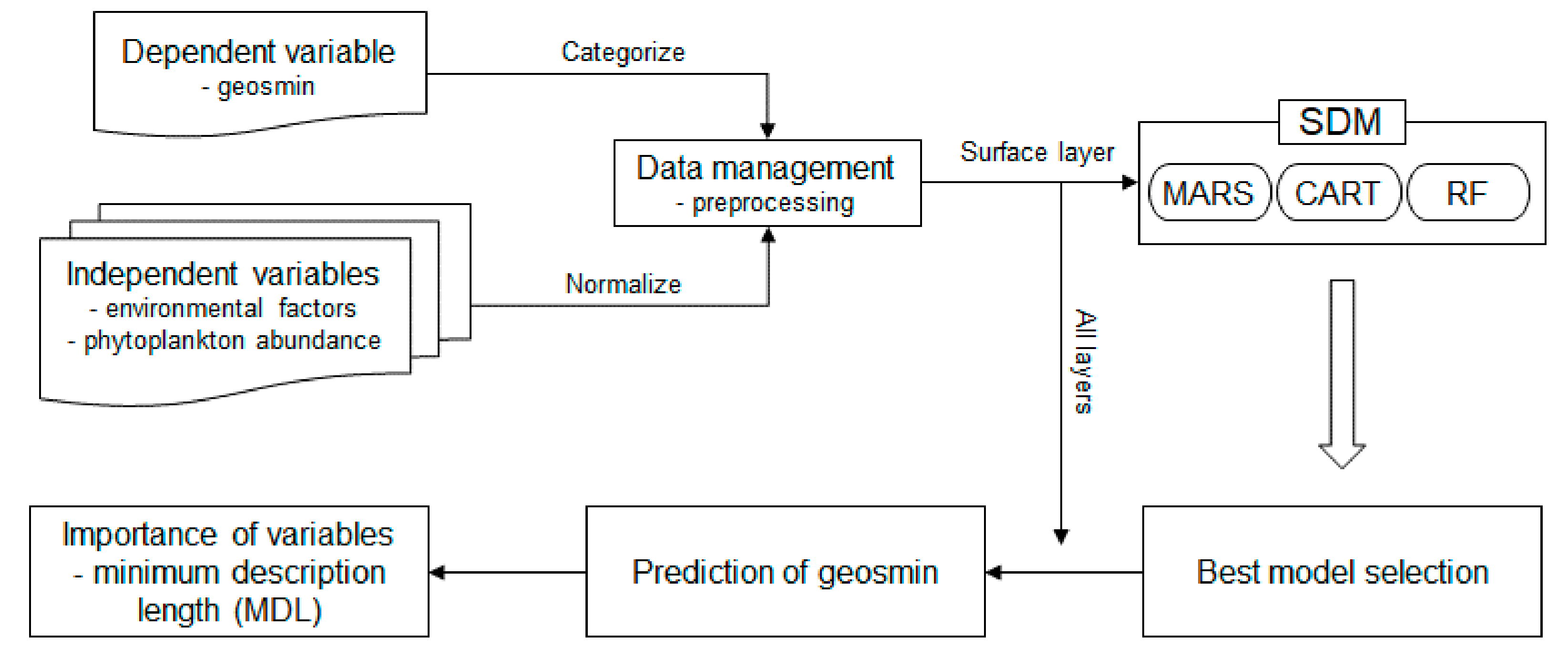


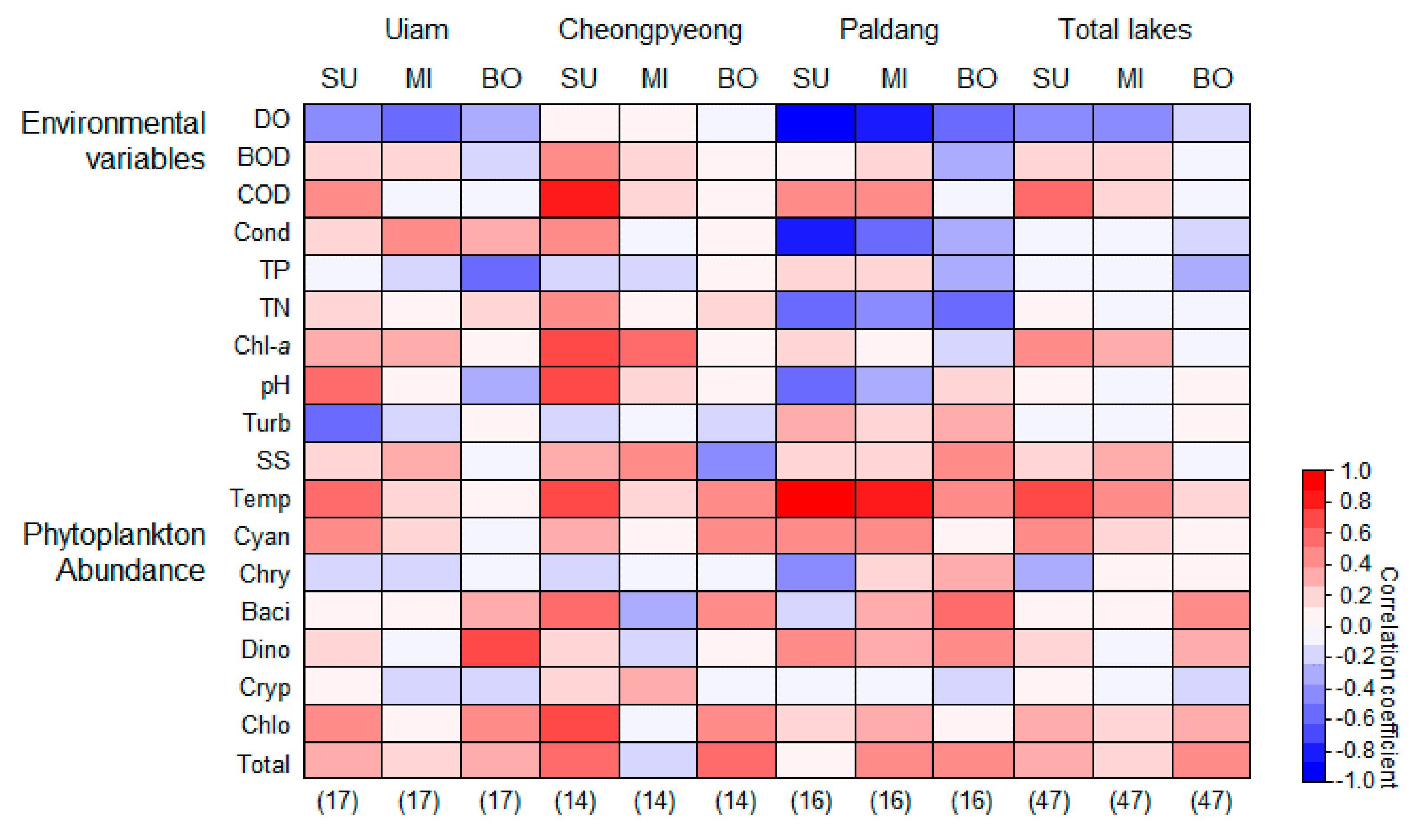
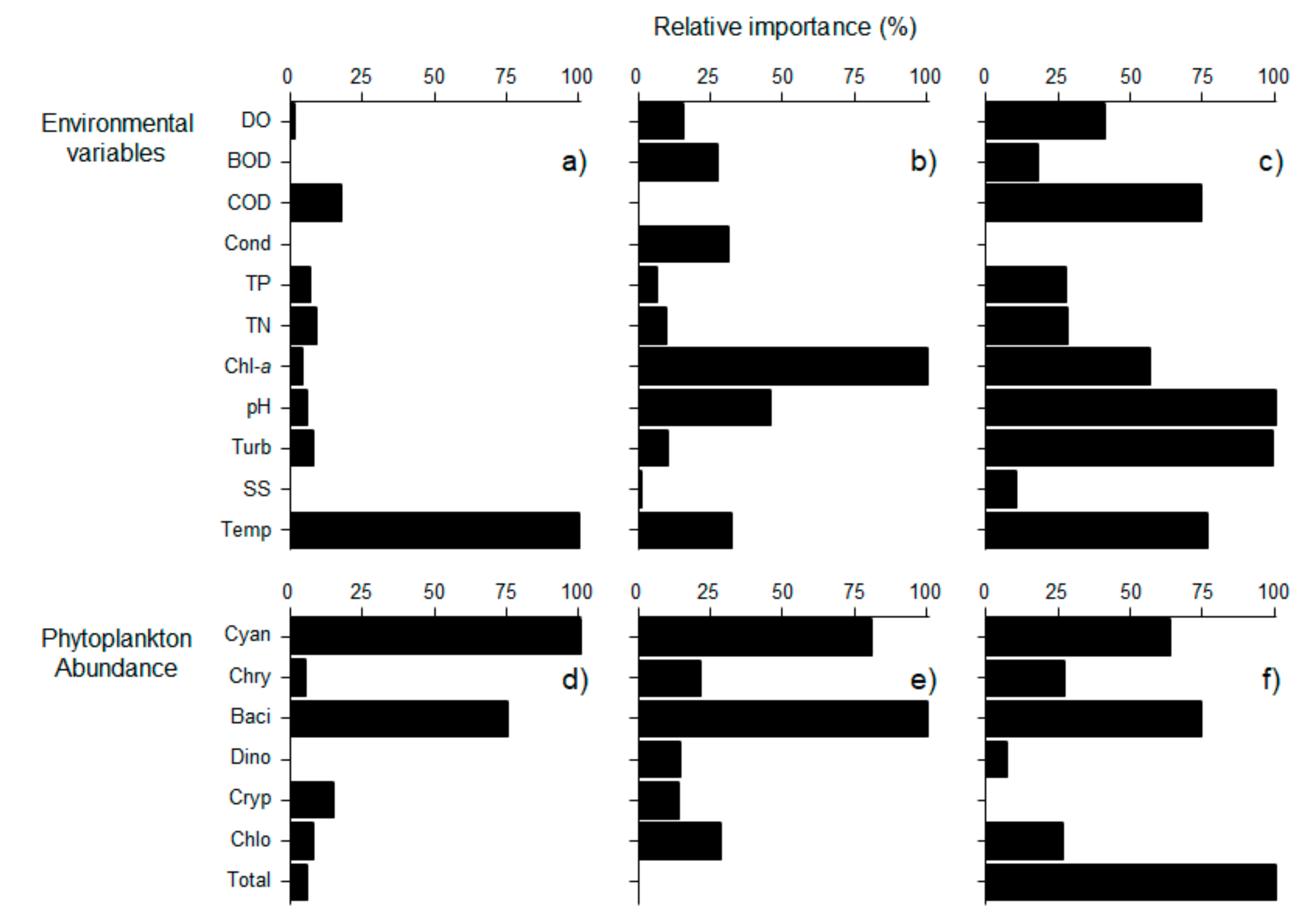
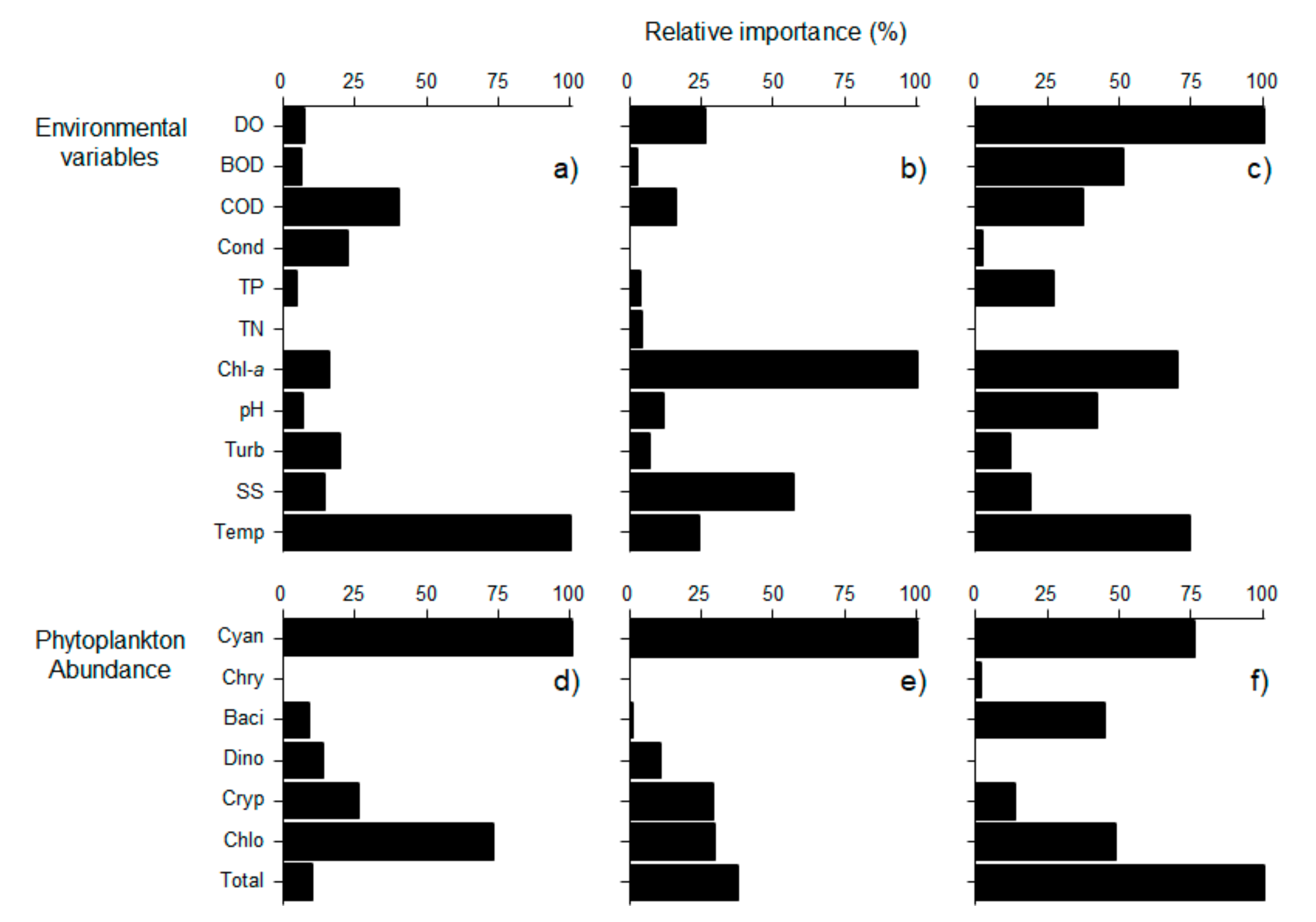
| Factors | Lakes | ||
|---|---|---|---|
| Uiam | Cheongpyeong | Paldang | |
| Watershed area (km2) | 7709 | 9921 | 23,800 |
| Total storage (106 m3) | 80 | 185.5 | 244 |
| Effective storage (106 m3) | 57.52 | 82.6 | 18 |
| Inflow (106 m3/year) | 5323 | 6837 | 17,020 |
| Outflow (106 m3/year) | 5322 | 6836 | 16,988 |
| Dam height (m) | 23 | 31 | 29 |
| Residence time (day) | 7.3 | 9.3 | 12.9 |
| Variables | Abbreviation | Units | Methods | |
|---|---|---|---|---|
| Independent variables | Cyanophyceae | Cyan | cell/mL | - |
| Chrysophyceae | Chry | cell/mL | - | |
| Bacillariophyceae | Baci | cell/mL | - | |
| Dinophyceae | Dino | cell/mL | - | |
| Cryptophyceae | Cryp | cell/mL | - | |
| Clorophyceae | Chlo | cell/mL | - | |
| Total abundance | Total | cell/mL | - | |
| Water Temperature | Temp | °C | Multimeter in the field | |
| Conductivity | Cond | μS/cm | ||
| Turbidity | Turb | NTU | ||
| pH | pH | - | ||
| Dissolved Oxygen | DO | mgO2/L | ||
| Chemical Oxygen Demand | COD | mgO2/L | CODMn | |
| Biochemical Oxygen Demand | BOD | mgO2/L | Membrane Electrode Method | |
| Total Phosphorous | TP | mg/L | Ascorbic acid analysis | |
| Total Nitrogen | TN | mg/L | Ascorptiometric analysis | |
| Suspended Solid | SS | mg/L | GF/C | |
| Chlorophyll a | Chl-a | μg/L | Ascorptiometric analysis | |
| Dependent variables | Geosmin | - | ng/L | HS-SPME |
| Category | A (≤25%) | B (25–50%) | C (50–75%) | D (>75%) |
|---|---|---|---|---|
| Range of geosmin (n) | ≤4 (45) | 4–6 (28) | 6–10 (34) | >10 (34) |
| Dataset | Model | Environmental Variables | Phytoplankton Abundance | ||
|---|---|---|---|---|---|
| AUC | Accuracy | AUC | Accuracy | ||
| Four categories (A–D) | MARS | 0.724 | 0.553 | 0.623 | 0.447 |
| CART | 0.761 | 0.617 | 0.713 | 0.574 | |
| RF | 0.974 | 0.809 | 0.934 | 0.681 | |
| Category with highest geosmin concentration (D) | MARS | 0.904 | 0.809 | 0.780 | 0.745 |
| CART | 0.790 | 0.830 | 0.816 | 0.787 | |
| RF | 0.969 | 0.872 | 0.914 | 0.851 | |
| Dataset | Layer | Environmental Variables | Phytoplankton Abundance | ||
|---|---|---|---|---|---|
| AUC | Accuracy | AUC | Accuracy | ||
| Four categories (A–D) | Surface | 0.974 | 0.809 | 0.934 | 0.681 |
| Middle | 0.976 | 0.766 | 0.923 | 0.745 | |
| Bottom | 0.981 | 0.787 | 0.937 | 0.617 | |
| Category with highest geosmin concentration (D) | Surface | 0.969 | 0.872 | 0.914 | 0.851 |
| Middle | 0.967 | 0.851 | 0.906 | 0.787 | |
| Bottom | 0.981 | 0.830 | 0.920 | 0.830 | |
Publisher’s Note: MDPI stays neutral with regard to jurisdictional claims in published maps and institutional affiliations. |
© 2021 by the authors. Licensee MDPI, Basel, Switzerland. This article is an open access article distributed under the terms and conditions of the Creative Commons Attribution (CC BY) license (https://creativecommons.org/licenses/by/4.0/).
Share and Cite
Kwon, Y.-S.; Cho, I.-H.; Kim, H.-K.; Byun, J.-H.; Bae, M.-J.; Kim, B.-H. Prediction of Geosmin at Different Depths of Lake Using Machine Learning Techniques. Int. J. Environ. Res. Public Health 2021, 18, 10303. https://doi.org/10.3390/ijerph181910303
Kwon Y-S, Cho I-H, Kim H-K, Byun J-H, Bae M-J, Kim B-H. Prediction of Geosmin at Different Depths of Lake Using Machine Learning Techniques. International Journal of Environmental Research and Public Health. 2021; 18(19):10303. https://doi.org/10.3390/ijerph181910303
Chicago/Turabian StyleKwon, Yong-Su, In-Hwan Cho, Ha-Kyung Kim, Jeong-Hwan Byun, Mi-Jung Bae, and Baik-Ho Kim. 2021. "Prediction of Geosmin at Different Depths of Lake Using Machine Learning Techniques" International Journal of Environmental Research and Public Health 18, no. 19: 10303. https://doi.org/10.3390/ijerph181910303
APA StyleKwon, Y.-S., Cho, I.-H., Kim, H.-K., Byun, J.-H., Bae, M.-J., & Kim, B.-H. (2021). Prediction of Geosmin at Different Depths of Lake Using Machine Learning Techniques. International Journal of Environmental Research and Public Health, 18(19), 10303. https://doi.org/10.3390/ijerph181910303








